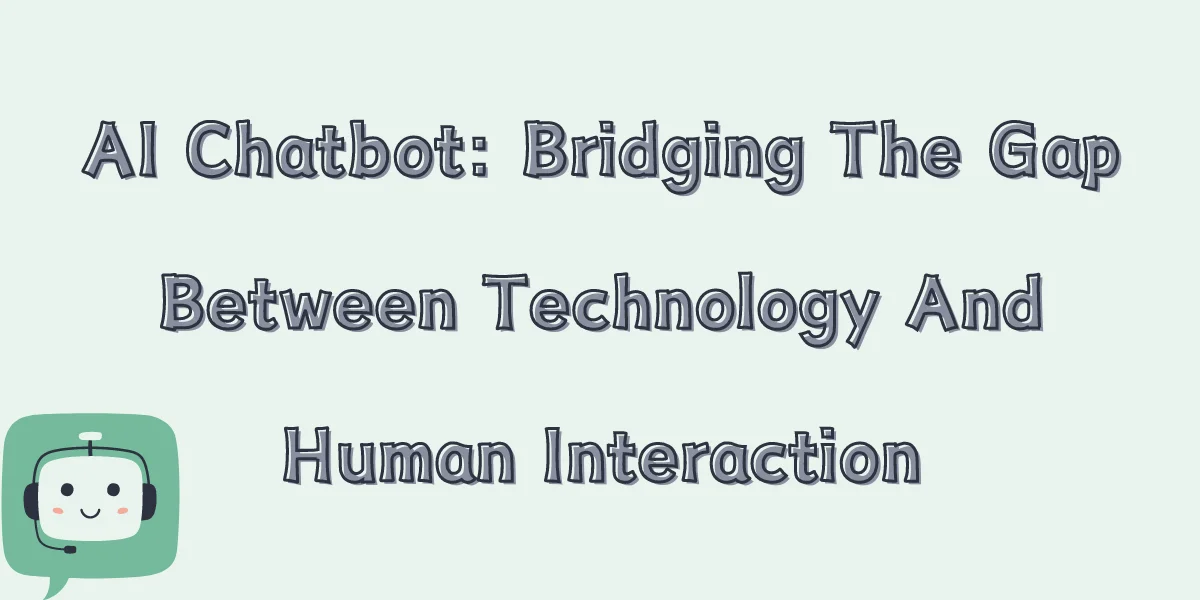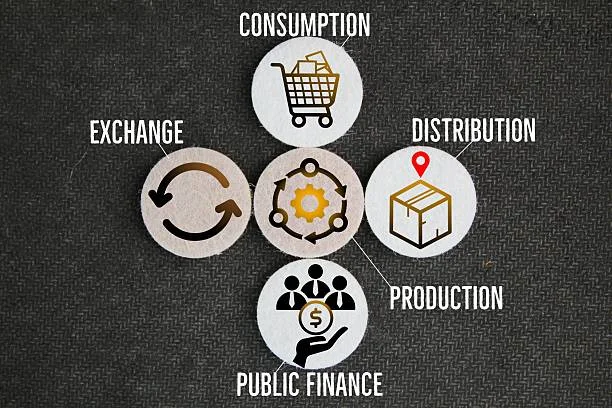TECHNOLOGY
AI Chatbot: Bridging The Gap Between Technology And Human Interaction

Introduction
In an era where technology intertwines seamlessly with everyday life, AI chatbots have emerged as pivotal tools, transforming the way humans interact with machines. These sophisticated programs have transcended their original roles as mere customer service assistants, evolving into dynamic entities capable of understanding and responding to human emotions, behaviors, and needs. As we delve deeper into the world of AI chatbots, it becomes clear that they are not just bridging the gap between technology and human interaction; they are redefining the very nature of communication in the digital age.
What Is AI Chatbot?
AI chatbot is an artificial intelligence-driven software designed to simulate human conversation. These chatbots leverage natural language processing (NLP) and machine learning algorithms to understand and respond to user inputs in a conversational manner. Unlike traditional rule-based chatbots, AI chatbots can learn from interactions, making them increasingly sophisticated over time.
AI chatbots operate across various platforms, from websites and mobile apps to social media channels. They serve diverse purposes, such as answering queries, providing recommendations, and even engaging in small talk. The goal is to create a seamless interaction where users feel as though they are conversing with a human rather than a machine. This capacity to mimic human conversation positions AI chatbots as powerful tools in enhancing user experiences across different industries.
How Does AI Chatbot Work?
The functionality of an AI chatbot is underpinned by several advanced technologies, each playing a crucial role in making these systems intelligent and responsive.
Natural Language Processing (NLP)
NLP is the cornerstone of AI chatbot technology. It enables the chatbot to understand, interpret, and respond to human language. By breaking down sentences into their fundamental components, NLP allows chatbots to grasp context, identify intent, and generate relevant responses. This process involves tokenization, sentiment analysis, and language modeling, all of which work together to create meaningful and coherent interactions.
Machine Learning Algorithms
Machine learning (ML) is what allows AI chatbots to learn and improve over time. Through continuous exposure to data and interactions, these algorithms identify patterns, adapt to new inputs, and enhance the chatbot’s ability to predict and respond accurately. Supervised learning, reinforcement learning, and deep learning are among the various ML approaches used to train chatbots, ensuring they become more intuitive and effective with each conversation.
Integration with Backend Systems
To provide valuable and personalized responses, AI chatbots are often integrated with backend systems such as databases, CRMs, and APIs. This integration allows the chatbot to fetch real-time data, understand user preferences, and offer tailored solutions. For instance, a customer service chatbot integrated with a company’s CRM can access customer history and provide personalized support, enhancing the overall user experience.
Continuous Improvement Through Feedback Loops
AI chatbots utilize feedback loops to refine their responses. By analyzing user feedback and interactions, chatbots can identify areas of improvement, adjust their algorithms, and enhance future performance. This iterative process is crucial for maintaining the relevance and accuracy of the chatbot’s responses, ensuring it remains a valuable tool for users.
Benefits of Using AI Chatbot?
AI chatbots offer numerous advantages that can transform the way businesses operate and interact with their customers. These benefits extend beyond simple automation, providing meaningful enhancements to user experiences.
- 24/7 Availability: AI chatbots are available around the clock, ensuring that users can receive assistance at any time of day, regardless of time zones or business hours.
- Cost Efficiency: By automating routine tasks and customer interactions, businesses can reduce operational costs while maintaining high levels of service.
- Scalability: AI chatbots can handle multiple interactions simultaneously, allowing businesses to scale their customer service efforts without the need for additional human resources.
- Consistency: Unlike human agents, AI chatbots provide consistent responses, ensuring that all users receive the same level of service.
- Data Collection and Analysis: AI chatbots can gather valuable data from user interactions, providing businesses with insights that can be used to improve products, services, and marketing strategies.
How Do AI Chatbots Enhance Customer Service?
AI chatbots are revolutionizing customer service by offering faster, more efficient, and personalized solutions to users. Their ability to handle high volumes of inquiries with precision makes them indispensable tools for modern businesses.
Instant Response and Resolution
One of the primary advantages of AI chatbots in customer service is their ability to provide instant responses. Unlike human agents who may be limited by availability and capacity, AI chatbots can manage multiple queries simultaneously, reducing wait times and ensuring that customers receive prompt assistance. This immediacy not only enhances customer satisfaction but also helps in building stronger customer relationships.
Personalized Customer Interactions
AI chatbots can personalize interactions by using data-driven insights to tailor responses based on individual user preferences and past behaviors. For example, a chatbot in an e-commerce setting might suggest products based on a customer’s previous purchases or browsing history. This level of personalization can lead to more meaningful interactions and increase the likelihood of conversions.
Efficient Handling of Routine Inquiries
Routine inquiries, such as tracking orders, resetting passwords, or checking account balances, can be efficiently managed by AI chatbots. This allows human agents to focus on more complex issues that require a higher level of expertise. By offloading these repetitive tasks to chatbots, businesses can improve overall service efficiency and reduce the workload on their customer support teams.
What Role Do AI Chatbots Play in Business Communication?
AI chatbots are transforming the landscape of business communication by providing innovative solutions that enhance efficiency, responsiveness, and engagement. As businesses increasingly rely on digital interactions, AI chatbots have become essential tools that streamline communication processes, both internally among employees and externally with customers. These chatbots offer a unique blend of automation and personalization, making them invaluable in modern business environments where speed and accuracy are paramount.
Enhancing Internal Communication
Within organizations, AI chatbots are revolutionizing internal communication by automating routine tasks and facilitating seamless information flow. They can manage scheduling, send reminders, and answer common inquiries, allowing employees to focus on more strategic initiatives. This automation not only improves productivity but also ensures that communication is consistent and timely. By reducing the administrative burden on staff, AI chatbots help maintain a more efficient and organized workplace, where important tasks are completed without delays.
Improving Customer Engagement
Externally, AI chatbots play a crucial role in enhancing customer engagement. They serve as the first point of contact for customers, handling inquiries, providing product information, and resolving issues in real-time. This technology, which includes both general-purpose bots and more niche applications like NSFW AI chat, significantly improves the customer experience through instant and personalized interactions, leading to higher satisfaction and loyalty.
Gathering and Analyzing Data
AI chatbots also contribute to business communication by gathering and analyzing data from customer interactions. This data provides valuable insights into customer behavior, preferences, and needs, which businesses can use to refine their strategies and improve their offerings. By leveraging the analytical capabilities of AI chatbots, companies can make data-driven decisions that enhance communication effectiveness and drive business growth. This ability to continuously learn from interactions ensures that AI chatbots remain relevant and valuable tools in an ever-evolving digital landscape.
How Are AI Chatbots Improving Accessibility?
AI chatbots are also enhancing accessibility for users with disabilities by integrating with assistive technologies. These chatbots, including specialized versions such as NSFW character AI, work alongside tools like screen readers to provide a seamless experience for visually impaired users. By offering voice command options and adjusting content presentation, these chatbots ensure that digital environments are more inclusive and navigable for all users.
Multilingual Support
One of the key ways AI chatbots are improving accessibility is through multilingual support. Chatbots equipped with natural language processing capabilities can communicate in multiple languages, allowing users from different linguistic backgrounds to interact with them in their preferred language. This feature is particularly important for global businesses that need to cater to a diverse customer base. By offering services in various languages, AI chatbots ensure that language is not a barrier to accessing information or services, thus promoting inclusivity and global reach.
Assistive Technology Integration
AI chatbots are also enhancing accessibility for users with disabilities by integrating with assistive technologies. For instance, chatbots can work alongside screen readers to provide a seamless experience for visually impaired users. By converting text to speech and offering voice command options, chatbots enable users with visual impairments to navigate websites, access information, and complete transactions independently. Additionally, AI chatbots can be designed to recognize and respond to voice commands, making them more accessible to users who may have difficulty using traditional input methods like keyboards or touchscreens.
Personalized User Experiences
AI chatbots can further improve accessibility by offering personalized user experiences tailored to individual needs. For example, chatbots can be programmed to adjust their language complexity or provide visual aids for users with cognitive disabilities. This level of customization ensures that all users, regardless of their abilities, can engage with technology in a way that suits their specific needs. By offering a more personalized and adaptable interface, AI chatbots contribute to creating a more inclusive digital environment where everyone can participate fully.
Ethical Considerations of AI Chatbot
As AI chatbots become more prevalent, it is essential to consider the ethical implications of their use. These considerations range from data privacy concerns to the potential impact on employment.
Data Privacy and Security
One of the primary ethical concerns surrounding AI chatbots is data privacy. Chatbots often handle sensitive information, such as personal details and financial data. It is crucial that businesses implementing AI chatbots ensure that this data is protected through robust encryption and secure storage practices. Additionally, transparency about data usage and obtaining user consent is essential to maintaining trust and compliance with privacy regulations.
Impact on Employment
The rise of AI chatbots has raised concerns about their impact on employment, particularly in customer service roles. While chatbots can handle routine tasks, there is a risk that their widespread adoption could lead to job displacement. It is important for businesses to consider how they can integrate chatbots in a way that complements rather than replaces human workers. This might involve using chatbots to handle simple inquiries while allowing human agents to focus on more complex issues that require empathy and critical thinking.
Ethical AI Development
Ensuring that AI chatbots are developed and deployed ethically involves avoiding biases in their algorithms. If not carefully managed, chatbots can inadvertently reinforce stereotypes or provide biased responses based on the data they are trained on. Developers must strive to create AI systems that are fair, unbiased, and inclusive, considering the diverse range of users who will interact with them.
Future Development of AI Chatbots
The future of AI chatbots, including more specialized applications like NSFW AI, promises significant advancements as technology continues to evolve. These developments are expected to bring about more intuitive, emotionally intelligent systems that can offer personalized and empathetic interactions, transforming how businesses and individuals engage with digital tools.
Conclusion
AI chatbots represent a significant leap forward in bridging the gap between technology and human interaction. They are more than just tools for automation; they are becoming integral to the way we communicate, access information, and receive services. As technology continues to advance, AI chatbots will undoubtedly play an even more prominent role in shaping the future of human-machine interaction. By embracing the potential of AI chatbots while addressing ethical considerations, we can create a future where technology enhances, rather than replaces, the human experience.
TECHNOLOGY
Your Access, Upgraded: The Professional Benefits of RM1.to

In today’s fast-paced digital economy, professionals are constantly seeking tools that streamline workflow, increase efficiency, and maintain security. One platform that has been gaining attention in the online workforce community is rm1.to. Designed to provide secure and efficient access to specialized digital services, rm1.to is redefining how professionals work, collaborate, and manage tasks in a digital-first environment.
Simplified Access for Professional Tasks
One of the standout benefits of RM1.to is its focus on streamlined access. For many professionals, managing multiple digital tools, accounts, and permissions can be a time-consuming and error-prone process. RM1.to addresses this by offering a centralized platform where users can quickly access the services they need.
Whether it’s specialized data work, content creation, or technical support, RM1.to ensures that professionals can connect with verified service providers efficiently. By eliminating the usual friction associated with task assignment, approval, and payment, users can focus on productivity rather than administrative hurdles.
Enhanced Security for Peace of Mind
Security is a top priority in any professional setting, and RM1.to integrates it as a core feature. Traditional methods of managing access and digital collaboration can leave sensitive information exposed to risk. RM1.to mitigates this with built-in protections for both clients and service providers.
For professionals, this means confidence in every interaction. Payments are securely handled, services are verified, and access is monitored to prevent unauthorized use. The platform’s focus on transparency and accountability ensures that tasks are delivered reliably, reducing disputes and creating a trustworthy environment for all users.
Efficiency That Supports Growth
Another major benefit of RM1.to is its ability to support fast, efficient workflows. In the modern digital workforce, speed is often as critical as accuracy. RM1.to allows professionals to delegate micro-tasks quickly without worrying about complex onboarding or verification processes.
By combining rapid access with secure, verified transactions, the platform allows individuals and teams to scale their operations efficiently. Professionals can take on more projects, meet deadlines faster, and maintain high-quality standards—all without compromising security or accountability.
Flexibility for Diverse Professional Needs
The versatility of RM1.to is another reason it appeals to professionals. The platform is not limited to a single industry or type of task. From creative projects and technical support to data analysis and research, RM1.to can accommodate a wide range of professional requirements.
This flexibility enables professionals to adapt to evolving workloads, delegate tasks efficiently, and access specialized expertise on-demand. The platform acts as a bridge, connecting users with services that would otherwise require time-intensive searches or additional hires.
Building Trust Through Transparency
Trust is essential in any professional relationship, particularly in digital environments where users may never meet in person. RM1.to fosters trust through clear service descriptions, structured workflows, and feedback mechanisms. Both clients and service providers can review performance and maintain accountability, which strengthens collaboration and minimizes misunderstandings.
For professionals, this transparency not only ensures reliability but also allows them to make informed decisions when choosing services or partners. The platform’s structure encourages ethical practices and responsible usage, creating a professional ecosystem built on trust.
Conclusion
RM1.to offers a combination of security, efficiency, and flexibility that makes it a valuable tool for today’s digital professionals. By simplifying access, ensuring secure transactions, supporting scalable workflows, and fostering trust, the platform enables users to focus on what truly matters: delivering high-quality work and achieving professional goals.
In a world where digital tasks are growing in complexity and volume, RM1.to represents a meaningful upgrade in how professionals manage their work. Its features provide the support, speed, and reliability needed to thrive in a competitive digital workforce, making it a go-to platform for those seeking secure and efficient access to specialized services.
TECHNOLOGY
The Power of Curation: Ultimateshop’s Quality-First CC Strategy

In the digital world, access to information is only valuable when it is accurate, relevant, and well-organized. For platforms dealing with credit card (CC) data, this principle is even more critical. Raw data dumps may contain enormous amounts of information, but without proper curation, their utility ultimateshop is limited and their reliability questionable. ultshop.mobi has distinguished itself by adopting a quality-first strategy, using careful curation to transform large datasets into actionable, trustworthy resources quality-first CC.
The Limitations of Raw Data
Many platforms prioritize volume over precision, offering massive collections of CC information that are often outdated, duplicated, or poorly formatted. While this approach may appeal to users seeking large datasets, it comes with significant drawbacks. Errors, inconsistencies, and irrelevant entries increase the risk of flawed analysis or inefficient workflows. For developers, researchers, and testers, these issues mean extra time spent cleaning and verifying data, reducing productivity and increasing the potential for mistakes.
Ultimateshop recognized that the key to meaningful value is not simply the quantity of data but the quality. By prioritizing accuracy, organization, and usability, the platform provides users with curated datasets that are ready for immediate, reliable use quality-first CC.
Curation as a Core Strategy
At the heart of Ultimateshop’s approach is curation—a deliberate process of selecting, verifying, and refining data to ensure it meets strict quality standards. Every CC entry is evaluated for validity, accuracy, and relevance before inclusion. Duplicates are removed, formatting is standardized, and outdated or invalid entries are filtered out.
This rigorous curation process ensures that users receive datasets they can trust. Rather than sorting through thousands of questionable entries, users can focus on applying the information to research, testing, or legitimate project work. The curated approach turns potentially chaotic datasets into structured, usable resources.
Enhancing Usability Through Organization
Quality-first curation goes beyond validation—it also emphasizes organization and accessibility. Ultimateshop structures data in a way that is intuitive and user-friendly. Categories, tags, and consistent formatting make it easy to navigate even large datasets quality-first CC.
This thoughtful organization saves users significant time and reduces the risk of errors. For tasks that require precision and speed, such as testing payment systems or analyzing trends, the ability to access well-structured, reliable data is invaluable. Ultimateshop’s curated lists are not only accurate—they are actionable.
Trust and Reliability as Key Differentiators
In an industry where credibility is crucial, Ultimateshop’s quality-first strategy establishes trust. Users can rely on the platform to deliver accurate, up-to-date information without the frustration of sifting through unreliable entries. By emphasizing curation, Ultimateshop ensures that its datasets are consistently dependable, setting it apart from competitors that focus solely on volume.
Furthermore, this commitment to quality supports ethical and secure usage. Curated, verified data minimizes the risk of errors that could lead to misuse or security vulnerabilities, aligning the platform with responsible digital practices quality-first CC.
Continuous Improvement and Adaptation
Ultimateshop’s strategy is not static. The platform continuously updates and refines its curated datasets, incorporating new information while removing outdated entries. This dynamic approach ensures that users always have access to relevant, accurate data, allowing the platform to adapt to evolving needs and maintain its high standards over time.
Conclusion
Ultimateshop demonstrates the transformative power of curation in the CC data space. By prioritizing quality over quantity, verifying entries, organizing information effectively, and maintaining ongoing refinement, the platform provides reliable, actionable datasets that enhance efficiency and trust.
TECHNOLOGY
The Hidden Pathways of Vclubshop’s Digital Marketplace

In today’s interconnected world, the digital underground has become a sophisticated ecosystem where stolen data, illegal services, and cybercrime tools are exchanged. Among the platforms that have emerged in this shadowy landscape is vclubshop, a marketplace known for facilitating the trade of compromised data and other illicit digital goods vclub shop. Understanding how such marketplaces operate can help individuals and organizations strengthen their cybersecurity posture and respond effectively to emerging threats.
1. Exploring the Structure of Vclubshop
Vclubshop functions similarly to a legitimate e-commerce platform, but with an illicit purpose. Its structure includes several key elements:
Product Listings – Stolen data, including login credentials, payment information, and personal identity records, is organized for sale.
Seller Ratings and Reviews – Like legal marketplaces, buyers assess sellers based on feedback and reputation, which fosters trust in an otherwise anonymous environment.
Secure Transactions – Cryptocurrencies are typically used to maintain anonymity and reduce the traceability of purchases.
Anonymity Tools – Users often rely on VPNs, encryption, and other privacy measures to avoid detection by authorities.
By mimicking the structure of legitimate marketplaces, platforms like Vclubshop create a sense of order that allows illicit transactions to occur efficiently.
2. The Lifecycle of Data in the Marketplace
Stolen data rarely remains isolated; it passes through multiple stages before reaching end-users:
Acquisition – Hackers obtain data through breaches, phishing, malware, or social engineering.
Verification and Packaging – Data is often checked for validity and organized into packages for sale.
Marketplace Listing – The verified data is uploaded to platforms like Vclubshop.
Purchase and Exploitation – Buyers use the data for identity theft, financial fraud, or account takeovers, or resell it in other underground markets.
This pipeline shows how a single breach can have far-reaching consequences in the digital ecosystem.
3. Why Vclubshop Persists
Several factors contribute to the resilience of underground marketplaces:
High Demand – Stolen data fuels identity theft, fraud, and cyberattacks, creating a continuous market.
- Global and Decentralized Operations – Transactions cross borders, making enforcement and prosecution challenging.
Advanced Anonymity Measures – Cryptocurrency payments and encrypted communication systems protect both buyers and sellers.
These conditions create a marketplace that is difficult to disrupt and continuously adapts to law enforcement efforts.
4. The Risks to Individuals and Organizations
Even if someone is not directly interacting with platforms like Vclubshop, stolen information can impact them indirectly:
Account Compromise – Credentials sold on such marketplaces can be used to take over online accounts.
Financial Fraud – Payment information can be exploited for unauthorized transactions.
Identity Theft – Personal data can be used to create fraudulent documents or access services.
Awareness of these risks is the first step toward prevention.
5. Strategies for Protection
Protecting yourself and your organization from the effects of marketplaces like Vclubshop requires proactive measures:
Use unique, strong passwords for all accounts.
Enable multi-factor authentication wherever possible.
Monitor financial statements and credit reports regularly.
Keep software and devices updated to patch security vulnerabilities.
Educate users and employees about phishing and social engineering attacks.
For organizations, regular cybersecurity audits, network monitoring, and incident response planning are essential to minimizing exposure.
6. Understanding the Digital Underground
While platforms like Vclubshop operate outside the law, analyzing their structure and operations helps demystify the digital underground. By understanding the hidden pathways through which stolen data travels, individuals and businesses can take informed steps to secure sensitive information. Cybersecurity today is not optional—it is a critical part of navigating an increasingly digital world.

 ENTERTAINMENT1 month ago
ENTERTAINMENT1 month agoExploring the Kristen Archives: A Treasure Trove of Erotica and More

 LIFESTYLE9 months ago
LIFESTYLE9 months agoThe Disciplinary Wives Club: Spanking for Love, Not Punishment

 BUSINESS9 months ago
BUSINESS9 months agoBrand Visibility with Imprint Now and Custom Poly Mailers

 HEALTH8 months ago
HEALTH8 months agoHappy Hippo Kratom Reviews: Read Before You Buy!

 GENERAL5 months ago
GENERAL5 months ago5 Factors That Affect Tattoo Removal Success

 HOME IMPROVEMENT9 months ago
HOME IMPROVEMENT9 months agoThe Do’s and Don’ts of Renting Rubbish Bins for Your Next Renovation

 TECHNOLOGY8 months ago
TECHNOLOGY8 months agoDizipal 608: The Tech Revolution Redefined

 HEALTH5 months ago
HEALTH5 months agoYour Guide to Shedding Pounds in the Digital Age












